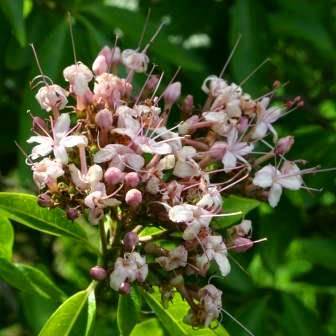
6 Clerodendrum glabrum Tree Seeds - Tinderwood - Worldwide Delivery
Check my rate
| Main centres: | 1-3 business days |
| Regional areas: | 3-4 business days |
| Remote areas: | 3-5 business days |

| Main centres: | 1-3 business days |
| Regional areas: | 3-4 business days |
| Remote areas: | 3-5 business days |
Clerodendrum glabrum Seeds
Clerodendrum glabrum commonly known as Tinderwood in English and Tontelhout in Afrikaans is a small tree with many traditional uses and scented flowers in summer. It is a small to medium-sized deciduous tree which grows up to 12 m high. It has simple, ovate leaves, opposite or arranged in whorls of three, with green petioles and smooth leaf margins. The leaves are often folded up from the midrib. When the leaves are crushed they produce a very strong smell. Typical of this species are the branchlets covered with small raised pale dots (lenticels). The flowers are bell-shaped with five mauve to pink flowers and four stamens, pinker than the petals, with yellow anthers. Flowers are arranged in rounded heads and are produced inland from November to April, and all year round along the coast. The round fruits (berries) are crowded at the tip of the branches. The berries are green before maturity, and become pale yellow when ripe. C. glabrum is commonly used as insects repellent. It was also traditionally used by Vha-venda to counter the effect of witchcraft, and the strong smell produced by the leaves is believed to repel polecats and hyenas, and was allegedly used by witches. The milky latex from this plant is smeared onto livestock for removal of ticks. The roots are used to treat the snakebites on livestock and people. Decoctions of leaves are used for treating coughs, colds, prolapse, wounds and diarrhea. The wood of the tree was used to start fire in the olden days. Infusions of the leaves were used to treat bad dreams. It has been a traditional skill and common knowledge that if one crushes leaves and rubs them on hands and face when collecting honey, the smell of the leaves repels the bees from attacking. You're buying a pack of 6 Seeds We'll supply you with all the germination & care instructions. |